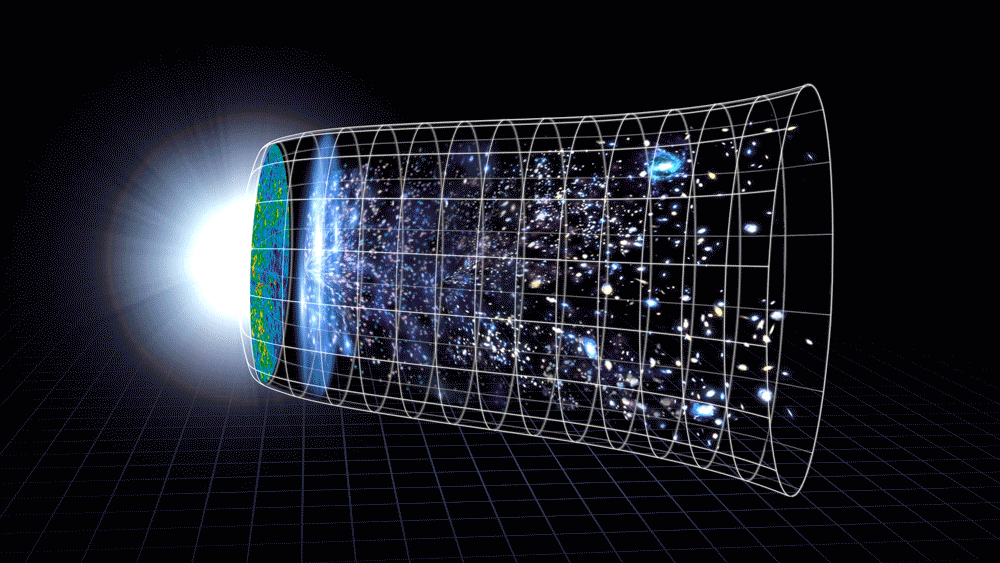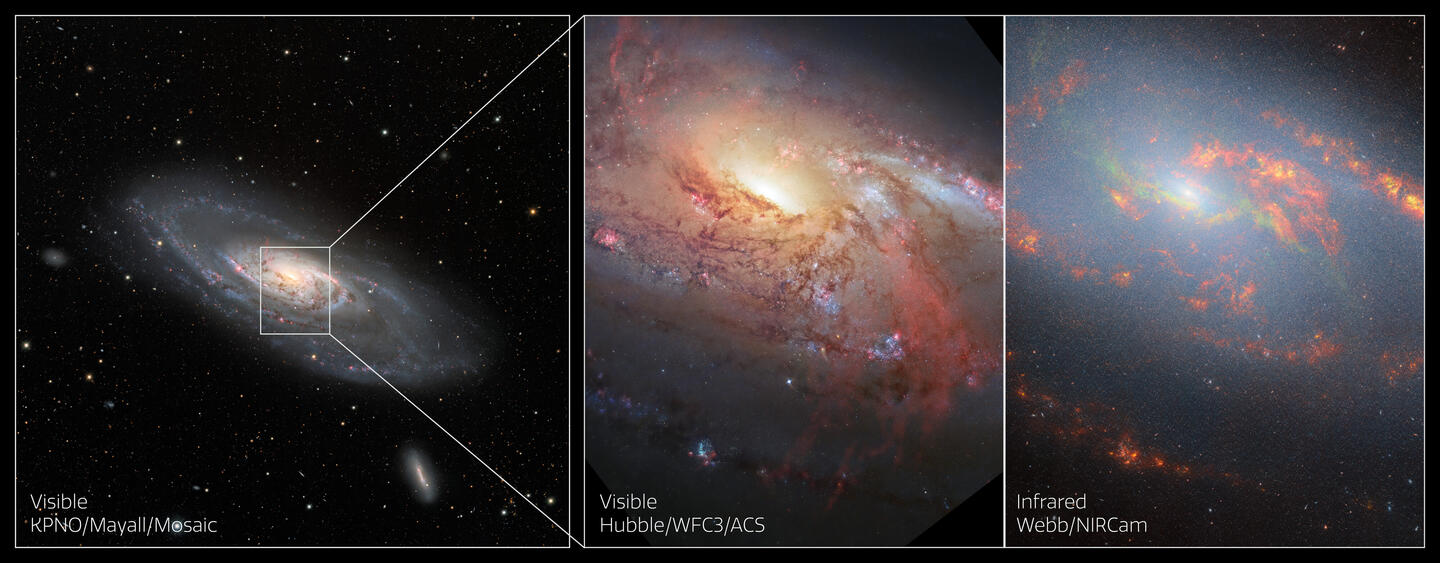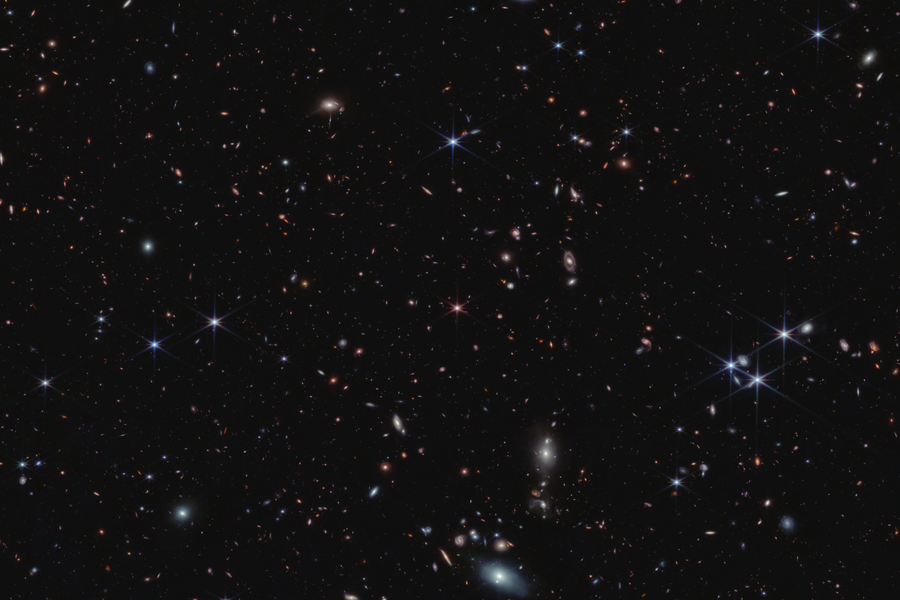- Name
- Roberto Molar Candanosa
- rmolarc1@jh.edu
- Office phone
- 443-997-0258
- Cell phone
- 443-938-1944
New observations from the James Webb Space Telescope suggest that a new feature in the universe—not a flaw in telescope measurements—may be behind the decadelong mystery of why the universe is expanding faster today than it did in its infancy billions of years ago.
The new data confirms Hubble Space Telescope measurements of distances between nearby stars and galaxies, offering a crucial cross-check to address the mismatch in measurements of the universe's mysterious expansion. Known as the Hubble tension, the discrepancy remains unexplained even by the best cosmology models.
"The discrepancy between the observed expansion rate of the universe and the predictions of the standard model suggests that our understanding of the universe may be incomplete," said Nobel laureate and lead author Adam Riess, a Bloomberg Distinguished Professor and professor of Physics and Astronomy at Johns Hopkins University. "With two NASA flagship telescopes now confirming each other's findings, we must take this [Hubble tension] problem very seriously—it's a challenge but also an incredible opportunity to learn more about our universe."
Published in The Astrophysical Journal, the research builds on Riess' Nobel Prize–winning discovery that the universe's expansion is accelerating owing to a mysterious "dark energy" permeating vast stretches of space between stars and galaxies.

Image caption: A representation of the evolution of the universe over 13.77 billion years. The far left depicts the earliest moment we can now probe, when a period of "inflation" produced a burst of exponential growth in the universe. (Size is depicted by the vertical extent of the grid in this graphic.) For the next several billion years, the expansion of the universe gradually slowed down as the matter in the universe pulled on itself via gravity. More recently, the expansion has begun to speed up again as the repulsive effects of dark energy have come to dominate the expansion of the universe.
Image credit: NASA's Goddard Space Flight Center
Riess' team used the largest sample of Webb data collected over its first two years in space to verify the Hubble telescope's measure of the expansion rate of the universe, a number known as the Hubble constant. They used three different methods to measure distances to galaxies that hosted supernovae, focusing on distances previously gauged by the Hubble telescope and known to produce the most precise "local" measurements of this number. Observations from both telescopes aligned closely, revealing that Hubble's measurements are accurate and ruling out an inaccuracy large enough to attribute the tension to an error by Hubble.
Still, the Hubble constant remains a puzzle because measurements based on telescope observations of the present universe produce higher values compared to projections made using the "standard model of cosmology," a widely accepted framework of how the universe works calibrated with data of cosmic microwave background, the faint radiation left over from the big bang.
While the standard model yields a Hubble constant of about 67-68 kilometers per second per megaparsec, measurements based on telescope observations regularly give a higher value of 70 to 76, with a mean of 73 km/s/Mpc. This mismatch has perplexed cosmologists for more than a decade because a 5-6 km/s/Mpc difference is too large to be explained simply by flaws in measurement or observational technique. (Megaparsecs are huge distances. Each is 3.26 million light-years, and a light-year is the distance light travels in one year: 9.4 trillion kilometers, or 5.8 trillion miles.)
Since Webb's new data rules out significant biases in Hubble's measurements, the Hubble tension may stem from unknown factors or gaps in cosmologists' understanding of physics yet to be discovered, Riess' team reports.
"The Webb data is like looking at the universe in high definition for the first time and really improves the signal-to-noise of the measurements,'' said Siyang Li, a graduate student working at Johns Hopkins University on the study.
The new study covered roughly a third of Hubble's full galaxy sample, using the known distance to a galaxy called NGC 4258 as a reference point. Despite the smaller dataset, the team achieved impressive precision, showing differences between measurements of under 2%—far smaller than the approximately 8-9% size of the Hubble tension discrepancy.
In addition to their analysis of pulsating stars called Cepheid variables, the gold standard for measuring cosmic distances, the team cross-checked measurements based on carbon-rich stars and the brightest red giants across the same galaxies. All galaxies observed by Webb together with their supernovae yielded a Hubble constant of 72.6 km/s/Mpc, nearly identical to the value of 72.8 km/s/Mpc found by Hubble for the very same galaxies.
The study included samples of Webb data from two groups that work independently to refine the Hubble constant, one from Riess' SH0ES team (Supernova, H0, for the Equation of State of Dark Energy) and one from the Carnegie-Chicago Hubble Program, as well as from other teams. The combined measurements make for the most precise determination yet about the accuracy of the distances measured using the Hubble Telescope Cepheid stars, which are fundamental for determining the Hubble constant.

Image caption: Three views of NGC 4258, also known as Messier 106, which is about 23 million light-years away in the constellation Canes Venatici. The first two images show it in visible light as seen by The Kitt Peak National Observatory and the Hubble Space Telescope. The image on the right is from the James Webb Space Telescope in the infrared.
Image credit: ESA/Webb, NASA & CSA, J. Glenn, KPNO/NOIRLab/NSF/AURA, the Hubble Heritage Team (STScI/AURA), R. Gendler, M.T. Patterso, T.A. Rector, D. de Martin & M. Zamani
Although the Hubble constant does not have a practical effect on the solar system, Earth, or daily life, it reveals the evolution of the universe at extremely large scales, with vast areas of space itself stretching and pushing distant galaxies away from one another like raisins in rising dough. It is a key value scientists use to map the structure of the universe, deepen their understanding of its state 13-14 billion years after the big bang, and calculate other fundamental aspects of the cosmos.
Resolving the Hubble tension could reveal new insights into more discrepancies with the standard cosmological model that have come to light in recent years, said Marc Kamionkowski, a Johns Hopkins cosmologist who helped calculate the Hubble constant and has recently helped develop a possible new explanation for the tension.
The standard model explains the evolution of galaxies, cosmic microwave background from the big bang, the abundances of chemical elements in the universe, and many other key observations based on the known laws of physics. However, it does not fully explain the nature of dark matter and dark energy, mysterious components of the universe estimated to be responsible for 96% of its makeup and accelerated expansion.
"One possible explanation for the Hubble tension would be if there was something missing in our understanding of the early universe, such as a new component of matter—early dark energy—that gave the universe an unexpected kick after the big bang," said Kamionkowski, who was not involved in the new study. "And there are other ideas, like funny dark matter properties, exotic particles, changing electron mass, or primordial magnetic fields that may do the trick. Theorists have license to get pretty creative."
Other authors are Dan Scolnic and Tianrui Wu of Duke University; Gagandeep S. Anand, Stefano Casertano, and Rachael Beaton of the Space Telescope Science Institute; Louise Breuval, Wenlong Yuan, Yukei S. Murakami, Graeme E. Addison, and Charles Bennett of Johns Hopkins University; Lucas M. Macri of NSF NOIRLab; Caroline D. Huang of The Center for Astrophysics | Harvard & Smithsonian; Saurabh Jha of Rutgers, The State University of New Jersey; Dillon Brout of Boston University; Richard I. Anderson of École Polytechnique Fédérale de Lausanne; Alexei V. Filippenko of University of California, Berkeley; and Anthony Carr of University of Queensland, Brisbane.
This research is supported by Department of Energy grant DE-SC0010007, the David and Lucile Packard Foundation, the Templeton Foundation, Sloan Foundation, JWST GO-1685 and GO-2875, HST GO-16744 and GO-17312, and the Christopher R. Redlich Fund.










